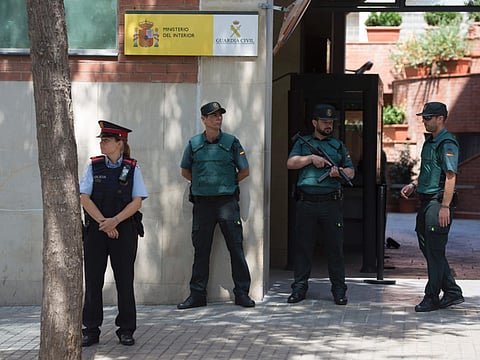Catalonia independence — a tale of two cities
In a referendum on October 1, voters will at last decide whether this region of northeast Spain should be independent

Three flags hang from the mayor’s office in Lleida, in northeast Spain. There are a burgundy-coloured municipal flag; the flag of the Catalan Autonomous Community, with four red bars on a yellow background; and the Spanish flag, with its three horizontal strips, red over yellow over red with the national coat of arms off-centre to the left. About 150km away, in the Catalan town of Berga, the balcony of the municipal hall displays just one flag: The Estelada (lone-starred banner). Its red star over the red stripes of the Catalan flag represents both state and revolution, and is an important insignia of Catalan independence.
Little wonder that come October 1, the regional government of Catalonia will have everything it needs in Berga to follow through on its promise to hold an independence referendum. Municipal premises will be transformed into voting offices, and all city officials will be asked to give a hand. Sister cities abroad will even be invited to send international observers. And just in case voters forget the date, an electronic clock has been fitted under the Estelada with a countdown marking the remaining days, hours and minutes until the referendum.
But in Lleida, things will be markedly different that day. Unlike in Berga, city hall won’t be assisting the referendum effort. By a slim margin, the Lleida city council voted against organising the poll. At the same session, the pro-Spanish majority invited Spain’s national football team — which has not played a match on Catalan soil for 13 years — to come and play at the municipal stadium. That was more than enough for Spanish media to depict Lleida, effectively a loyalist district surrounded by a pro-independence countryside, as the last holdout in a land of the separatists. The conservative daily ABC headlined one report ‘Lleida and the Rebellion of Catalan Cities’.
On the second floor of the Paeria, the 18th-century town hall, Lleida’s Mayor, Angel Ros, says he is surprised by journalists taking an interest in “a mayor’s office respecting the law in Catalonia. Before, you only heard about the law being broken”. The Spanish Constitutional Court has, at the government’s behest, issued several rulings that qualify the Catalan government’s efforts to organize a self-determination referendum without Madrid’s approval as unconstitutional.
But for Montse Venturos, the mayor of Berga, obeying Spanish laws is the least of her concerns. Elected on the left-wing, separatist ticket Candidatura d’Unitat Popular, she has even been arrested by police. In late 2016, an anti-independence association filed a lawsuit alleging that hoisting the Estelada at the last general elections violated the principle of neutrality. Police had to take her before a judge, as she refused to present herself when summoned. The court dismissed the case, but the prosecutor appealed.
“The decision to raise the Estelada was made by the city council after it was proposed by a local association,” Venturos explains. “The Spanish state has no business telling us what to do.”
Berga is considered one of the most solid bastions of separatism. It illustrates what some call a “mental disconnection” from Spain. Without awaiting a hypothetical independence, a significant portion of its residents already live as if they had nothing to do with a country they consider a neighbouring state. People watch regional television, listen to Catalan public radio and read local dailies, says a young Berga resident whose parents moved to Catalonia from southern Spain 30 years ago. “They get their information in Catalan only,” she says.
The local bookshop sells no books in Spanish, and visitors will rarely find a Spanish brochure at the tourist office. On Avinguda Canal Industrial in Berga, a self-service laundromat has its sign in two languages, Catalan and English. In the town centre, the only obvious symbol of the national reality are the yellow post office boxes.
Divided Opinion on Independence
Still, not everyone in Berga has the same views on independence. One resident, Albert, cites the pragmatism of his father. “He has two years left before he retires from work. He tells me, ‘Independence is all well, but who’ll pay my pension?’” Albert explains.
In Lleida, opinions are also divided. On a wall facing the city’s Segre River, someone has painted: “Denying the right to decide is fascism! Defend the referendum by all means.” And at the Lo Marraco cafe, in one of the city’s central plazas, a decidedly pro-independence patron named Ivan is sure that the referendum will take place in Lleida even without the help of city hall. But he doesn’t think that if the “Yes” vote wins, independence will be proclaimed within 48 hours, as the Catalan parliament claims.
That’s one of many questions awaiting answers in October. Until then — between the enthusiasm of some and the deep concerns of others — the people of Catalonia will have plenty to think about.
— Worldcrunch, 2017, in partnership with Le Figaro/New York Times News Service
Mathieu de Taillac is Le Figaro’s foreign correspondent in Spain.
Sign up for the Daily Briefing
Get the latest news and updates straight to your inbox



